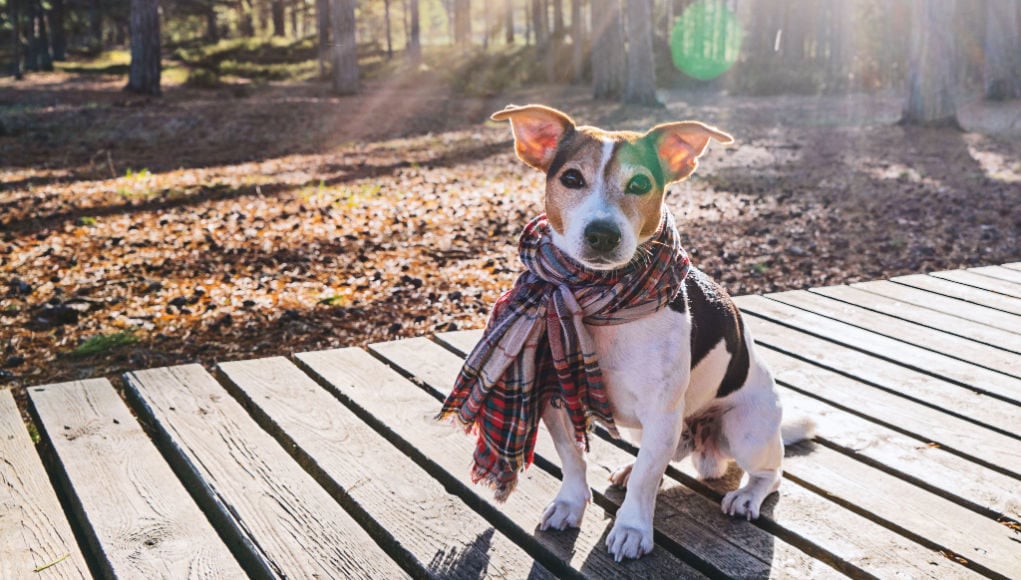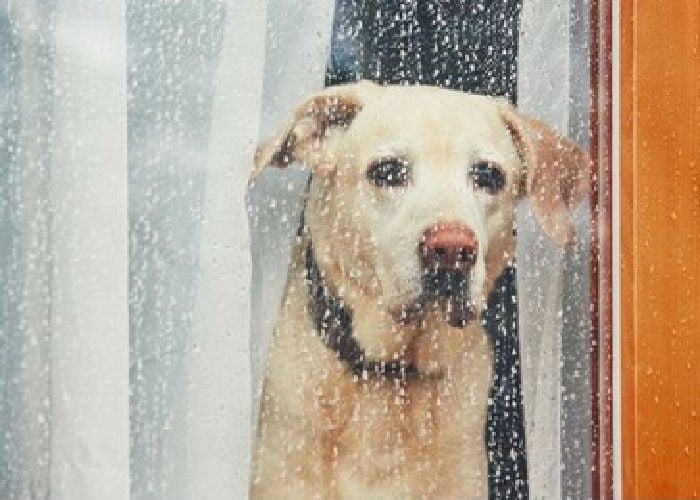Table of Contents
Sure, our canine friends are smart and intuitive, but do dogs know the seasons? Do they understand when and how their environment changes as seasons come and go?
Changes in season sure affect us, humans. There's just something about summer that makes us want to go hiking or swimming or go on a road trip.
On the other hand, there's also something about autumn and winter that just entices us to stay inside the house and bury ourselves in mountains of blankets while sipping a steaming cup of tea or hot chocolate.
Do the hot days of summer or chilly nights of winter affect our dogs, too?
In this article, let's explore how animals, especially dogs, understand seasons and how it affects their physical and behavioral well-being.
Do Dogs Know When Seasons Change?
Dogs don't understand calendars as we do, but they certainly do know the seasons.
In fact, all animals have their own way of knowing when seasons change!
This is especially true for animals in the wild. For some, understanding when and how seasons change could mean the world between life and death.
Animals have their own indicator called the environmental cue.
Just like birds, for example. They use a day's length as an environmental cue because it changes throughout the year in a very regular pattern.
If the days are longer like in summer or spring, that means they can lay and hatch their eggs because there will be plenty of food to feed their young.
They'd also know how to cool down when the temperature outside gets too hot.
But if they hatch late in the summer, they know their offspring might not survive the upcoming cold days because of the temperature and scarcity of food.
Same with birds, most animals are photoperiodic.
They know how to respond to changes in day length with the way their brains respond to light.
Domestic animals like dogs also instinctively understand the changes in season and it shows based on the changes in their mood, behavior, and even physical condition.
How Does the Change in Season Affect Dogs?
So how does the change in season affect our pets? In many ways, actually.
All animals adapt to the changes brought about by the shift in temperature and length of day.
This allows them to prepare to increase their chances of survival. (And yes, even our well-cared-for dogs have this instinct!)
Here's how the change in season could manifest in our pooch.
Change in Appetite
Your dog's eating habits will change depending on how hot or cold the season is.
During spring or summer, dogs instinctively eat less than normal because their brains tell them that there is still plenty of time to eat because the days are longer.
They'd have smaller appetites and lower metabolism rates.
On the other hand, our dog's body will require more energy when the temperature drops during autumn or winter to preserve body heat.
This is why you'd see them eat more than usual.
A slower metabolism for animals enhances their fat storage to instinctively prepare for reduced food availability during winter. (And that's regardless of whether they're domesticated or not!)
Change in Mood
Perhaps, you've also noticed how happier and more fun-seeker you are during summer and spring. The weather's just too nice to spend indoors, after all!
The same goes for our dogs. Since they are mostly intuitive and know how to respond to our mood swings, you'd probably notice them happier during the hot season than in cold.
Apart from that, there is also a known condition called SAD, or Seasonal Affective Disorder which affects both humans and pets.
It's basically when you get, well… sad during the colder days because of spending less time outside.
The same goes for our pets. You'll notice them be more lethargic, always sleeping, and needier than usual.
In some rare cases, our dogs can even be a bit more aggressive and may start to bark or howl more frequently.
Change in Behavior
Your dog's behavior corresponds to what's happening outside the house.
During a thunderstorm night, you'd see them more anxious and scared because of the thunder and lightning.
Rains can either make them scared or excited to explore because of the new scents hanging in the air.
When the weather is colder, you'd also notice them nap a bit longer—either to make the most out of the shorter daylight or to preserve more energy.
Physical Changes
Even our pet's coats change depending on the season.
You'd probably notice your dog's coat gets thinner during spring and summer and gets thicker during autumn or winter.
This is why it's important to not shave their coats off even how much we think it gets them hot.
They are actually pretty self-sufficient in regulating their body temperatures in extreme weather conditions.
You'll also notice them shed more during the colder months because of this.
Also, beware of the skin problems your dog can possibly experience during the change in season.
Their skin may dry out and get irritated because of the cold and dry weather, while the hotter season may bring certain problems like ticks and fleas.
Whatever the weather is, always take the time to inspect your dog's skin and coat to make sure he is happy and healthy as he can be (skin-wise!)
Effect in Health
And of course, just like us, humans, the change in season also has an effect on a dog's overall health.
Just as we can get colds from the cold weather, so do dogs too! But don't worry, they can't catch our colds virus and we can't catch theirs.
Apart from that, senior dogs may also get affected more than other dogs. Cold weather makes arthritis and joint pain symptoms more aggressive.
But not only senior dogs, mind you, even other pets who do not exercise enough might also get inflamed and stiff joints.
Be extra mindful in caring for them especially when you see lameness, irritability, and depression in your pet because of this.
Apart from their joints, winter can also be unkind to your dog's paws.
While it's important they still get to have their daily exercise even when it's cold outside, make sure they are properly geared for the cold.
Their exposure to harsh cold weather can make their paws at risk of trauma, frostbite, cracking, and drying.
Even when the snow is melted, the salt and chemicals used to melt them are also harmful to the paws.
To protect those cute little toe beans, you can check out these highly-rated winter boots for dogs on Amazon.
How to Take Care of Our Dogs From Changes in the Season?
While animals, including dogs, have their own way of protecting themselves from changes in the season, there are certain ways we can help them be more comfortable during this shift in weather.
Autumn and Winter Care for Dogs
Keeping our dogs warm should be our number one priority when it's cold outside.
Consider getting a coat for older dogs or dogs with thinner fur. Also, make sure your pet has a warm, cozy corner in the house where they can snuggle in.
There are warming beds or heating pads (like this!) they can use specifically for this season.
You can also keep your home at a warm and comfortable temperature at all times.
Maintaining physical activities is also important.
If it's too impossible to go outside for a walk, there are several activities you can do with them inside the comforts of your home to entertain them.
You can read more winter care tips for dogs in this article. You can also check out our podcast on winter risks and everything you need to know to prepare.
Summer Care for Dogs
While outdoor activities are more fun during summertime, there are also a lot of risks that come with them.
Heat stroke is among the top dangers for dogs this season. Keeping them cool and hydrated at all times will help them combat this complication.
To help you and your dog during the hot and humid weather, there are several dog summer essentials you can buy online for your dog to try.
Trust us, using a cooling pad, cooling vest, and portable fans or AC can make a huge difference.
Also, limiting, if not timing, your outdoor activities will be necessary to protect them from the harsh sun.
And remember, don't leave your dogs in an unattended car!
Check out our podcast on more summer care tips for dogs with BetterVet’s Dr. Lyndsey Kingsley.
Dog Care for Rainy Days
Regardless of the season, rainy days also come and go. It's just how the weather works these days, thanks to climate change.
Sure, it's cute letting our dogs stomp and play in the rain puddle, but keep in mind that rainy weather also comes with its own risks.
Just make sure your pet is equipped with raincoats and boots when walking outside.
Letting them play under the rainshower sometimes (just not always!) is okay too, so long as the downpour is not too heavy.
Dry them off completely afterward as moisture on the skin (especially folded skin!) can bring infection and diseases when left for too long.
When it's hurricane season, it's best to just keep your dog safe and sound inside the house.
Read our article on how to keep your dogs warm and dry during the rainy season.
FAQs on Dogs and Changes in Season
Do dogs understand time?
Dogs may not exactly know the concept of time like hours, minutes, and seconds just like humans do, but in fact, they do have a sense of time.
Since dogs love routines, they can sense when you're about to get home from work, but not that they can read the clock at 6 PM.
Actually, a fun fact, dogs smell the passing of time. Their super smell can sense the changes in the air.
They can smell the crisp, cool air in the morning and the hot air in the afternoon. Amazing, right?
Can dogs sense storms?
Just like with the passing of time, dogs can also sense when a storm is brewing.
They can also smell any change in the barometric pressure and the electrostatic charges that happen in the air when a storm is coming.
Not only that, but they can also hear low-frequency noises in the surrounding, like thunder happening someplace else!
Do animals feel cold like humans?
Like humans, animals also feel cold. However, the answer to how cold is cold for animals is on a case-to-case basis.
Some animals, as we know, are bred for extremely cold temperatures, while others thrive more in a summer-like temperature.
According to this article from the Smithsonian magazine, all vertebrates (animals with backbones, which, yes, includes humans, too!) share the same mechanism for understanding a range of temperatures.
This lets us know when to take shelter to warm up.
For dogs, experts say they will generally feel uncomfortable when the temperature drops to below 45° F, especially for breeds intolerant to cold weather.
Do Dogs Know The Season—Final Thoughts
There is no doubt: dogs are highly instinctive! So to the question do dogs know the seasons, the answer is yes, they definitely do.
Apart from their natural instinct and intuitiveness, they also have super senses that tell them when it's cold and when it's hot.
They understand how these seasons change over time and how it could possibly affect them if they don't prepare well enough.
It's also important for us, fur parents, to know how to help our pets get through every transition in weather.
Knowing how to care for them will ensure we have a happy and healthy pooch all year round!
















